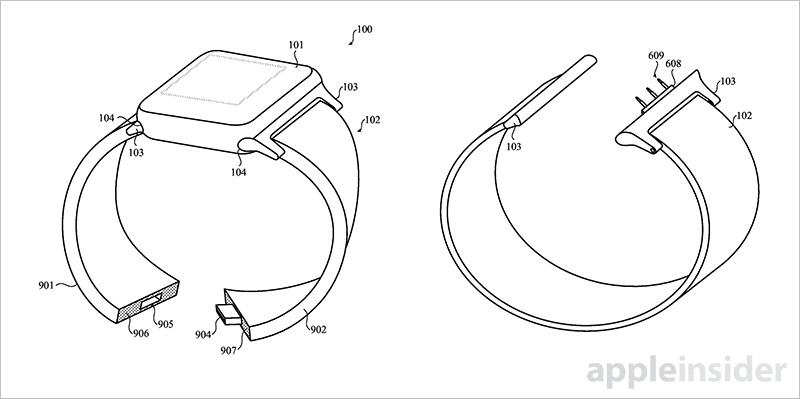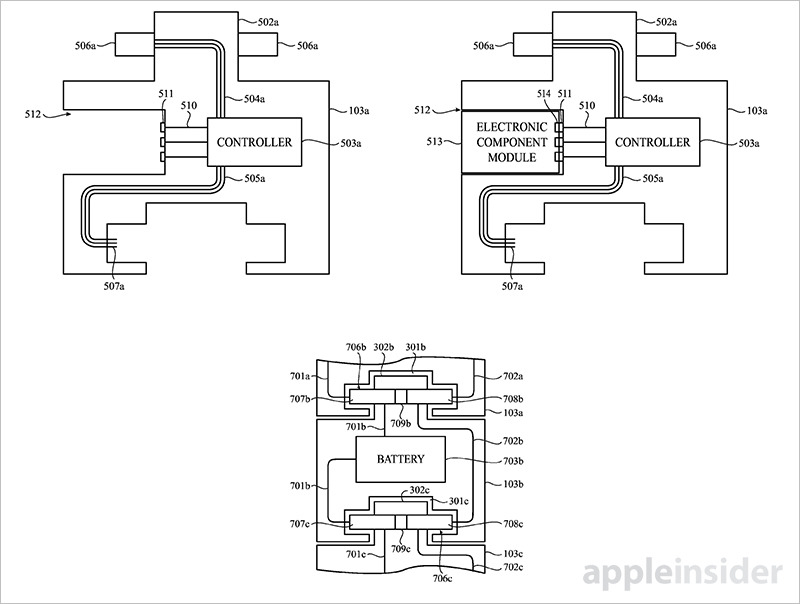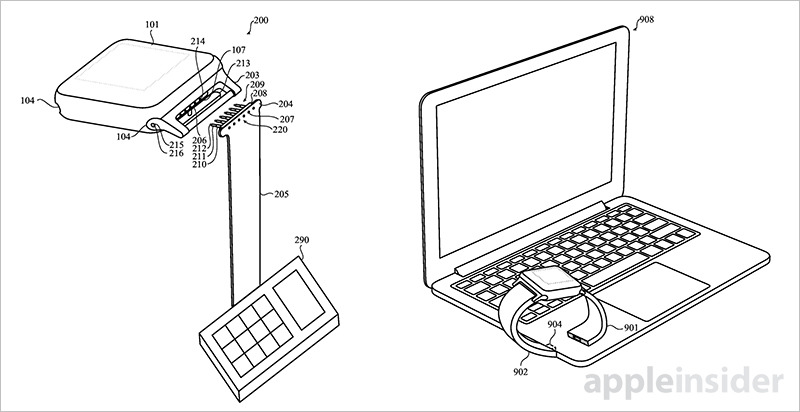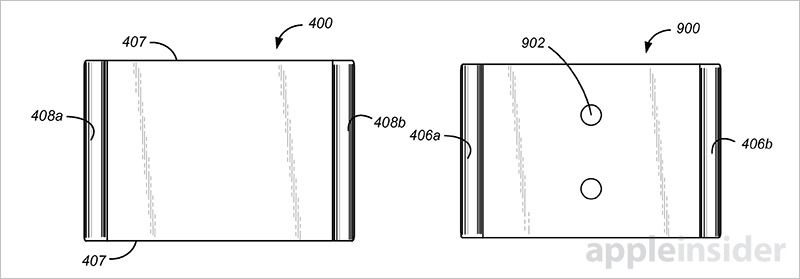A trio of Apple inventions published Thursday detail advanced strap designs with embedded electronic devices that connect via Apple Watch's diagnostics port, suggesting the wearable might soon support wireless charging battery packs, GPS receivers and more.
The patent applications, published by the U.S. Patent and Trademark Office, offer an intriguing taste of a modular hardware ecosystem created to extend Apple Watch functionality well beyond its current limitations. Instead of building sensor stacks, processors and other complex — and power hungry — components directly into a single chassis, Apple proposes a breaking those units out into a wide range of devices sold as watch band links, electrically connected in series or parallel.
As described in Apple's "Modular functional band links for wearable devices" application, modular designs present a flexible platform onto which users can add on the features, or hardware nodes, they want most. This level of customization promises optimized power consumption and a lean internal layout, two valuable commodities in a miniature computing platform.
Like any multifunction device, Apple notes Apple Watch can support accessories enabling a slew of value-added functionality, the most interesting being batteries, displays, processors, electricity generators, GPS sensors, cameras, thermometers, blood pressure sensors, sweat sensors and speakers. Arranged as links, the standalone devices connect to each other and ultimately to the 6-pin diagnostics port on Apple Watch.
Since the modules share a communication bus, Apple proposes unique identifiers be used to activate and send data to each separate link. For example, a signal coded with an audio identifier can be sent out by Watch and received and processed by a speaker module, while all other modules ignore the message.
In some embodiments, links themselves can act as an external port for accepting electronic components, perhaps a SIM card or powered memory module.
Apple's modular wearable link patent application was first filed for in February 2015 and credits Motohide Hatanaka, Douglas J. Weber, Brian Shadle, Alex M. Lee, David S. Herman, Patrick S. Wieler and Simon R. Lancaster-Larocque as its inventors.
Rumors that Apple would use the diagnostics connector as a jumping off point for a class of functional accessories circulated before the device saw public release. Speculation that the port was capable of transferring power and data in real time was confirmed a couple months later when Apple rolled out interactive Watch displays based on such technology at its retail stores.
Apple's "Portable electronic device connector" application, filed for in May 2015, serves as evidence that the company has at least considered the diagnostics port as a viable communications interface. Brandon B. Tulloch, Gordon C. Cameron, John Danby; Amaury J. Heresztyn and Nagarajan Kalyanasundaram are credited as inventors.
A specific example of Apple's module idea is revealed in an application for an "Auxiliary electronic device attachable to a wearable electronic device," which describes a band accessory featuring an internal power source and supporting wireless transmission circuitry. Basically a recharging strap or battery extender, the device would be slim enough to fit between the wearable and a user's wrist. Apple describes it as a "backpack" for Apple Watch.
Aesthetically, the auxiliary device is almost identical to Apple's current lineup of replacement straps, complete with attachment lugs and a variety of clasp mechanisms. Like the Sport Band, leather loop and new nylon style straps, the housing of Apple's proposed charging device can be constructed from any number of comfortable heat-dissipating materials, including plastic, rubber, silicone, aluminum, graphite and ceramic.
In some embodiments a GPS antenna is included as an optional user feature, offering location sensing capabilities not included in current Apple Watch variants. As GPS technology draws high levels of power, the auxiliary device in such arrangements might dedicate onboard battery capacity solely to the onboard positioning sensor. Gathered location data can be sent via Bluetooth, Wi-Fi or a wired path routed through Watch's 6-pin diagnostics port.
The design includes space for lenses that traverse through the device body, facilitating uninterrupted operation of Apple's optical heart rate sensor, which currently sits on the bottom of Apple Watch as an array of two light emitters and two receiving sensors.
Apple's auxiliary device for wearables patent application was first filed for in February 2015 and credits David I. Nazzaro, Tyler S. Bushnell and Javier Mendez as its inventors.
It remains unclear whether or not Apple intends to roll out functional Apple Watch accessories for its first-generation device. A more plausible scenario, perhaps, is an introduction alongside a successor device that might see announcement later this year.
 Mikey Campbell
Mikey Campbell





-m.jpg)






 Marko Zivkovic
Marko Zivkovic
 Mike Wuerthele
Mike Wuerthele
 Christine McKee
Christine McKee
 Amber Neely
Amber Neely
 Wesley Hilliard
Wesley Hilliard

 William Gallagher
William Gallagher










22 Comments
Does Apple call it a Diagnostics Port because that seems a poor name to me. It was always made sense to be used for advanced straps.
I love how Apple never sits on its laurels. It's never satisfied with the status quo. It's always looking for ways to improve its products.
But it can only do this because of its mission to "make the best products on Earth."
Its customers know this. Its would-be customers know this, and that drives its sales—at prices high enough to afford it the resources to continue its r&d, as well as its overall operations.
Apple's detractors jealously whine about the "Apple Tax", but its customers are grateful for its resolve to stay the course and just keep doing its successful actions to the benefit of us all.
Author: You don't need to write "filed for." The "for" is unnecessary. "Filed" is sufficient :)
A lot of possibilities here and it opens up the opportunity for 3rd-parties to make accessories that attach to the bands and therefore the watch. For example, Apple doesn't need to make a blood sugar monitor, somebody else can and worry about all the regulatory issues. The Watch then simply becomes the data collection and display device.